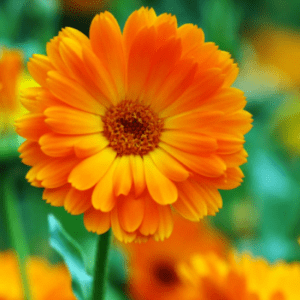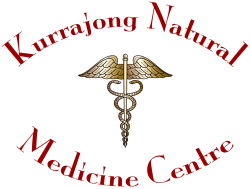Medicinal Herb: Calendula officinalis
Name of Herb
Biological Name:
(Calendula officinalis, C. officinalis)
Family:
Asteraceae
Other Names:
Garden marigold, Gold bloom, Goudsbloem, Holligold, Maravilla, Marigold, Marybud, Marygold, Nagotki, Neven, Pot marigold, Ringelblume, Souci

Introduction to C. officinalis:
Calendula grows as a common garden plant throughout North America and Europe. The golden-orange or yellow flowers of calendula have been used as medicine for centuries. Calendula is an annual garden plant with an anular, branched, hairy stem 1 to 2 feet high.
The leaves are alternate, sessile, spatulate or oblanceolate, dentate with widely spaced teeth, and hairy. From June to October, the plant bears large, yellow or orange, terminal flower heads.
Traditional Uses in Herbal Medicine of Calendula officinalis:
Uses for calendula include the treatment of inflammatory skin disorders, wound healing, and the treatment of other skin conditions. It may also be ingested for its anti-inflammatory and antispasmolytic, as well as its antimetastatic, cancer, cytotoxicity and genoprotective effects [1,2].
Calendula flowers are useful in reducing inflammation, wound healing, and as an antiseptic. Calendula can be used to treat various skin diseases, ranging from skin ulcerations to eczema. Internally, the soothing effects of calendula is used for stomach ulcers and inflammation. A sterile tea has also been applied in cases of conjunctivitis.
Historically, calendula is found to be antispasmodic, aperient, cholagogue, diaphoretic, vulnerary. An infusion of the flowers can be used for such gastrointestinal problems as ulcers, stomach cramps, colitis, and diarrhoea. It is also useful taken internally for fever, boils, abscesses, and to prevent recurrent vomiting. The fresh juice of the herb or flowers can substitute for the infusion. For external use, a good salve for wound healing [3,4] can be made from dried flowers or leaves, from the juice pressed out of the fresh flowers, or from the tincture. The salve or dilute tincture is good for bruises, sprains, pulled muscles, sores, and boils. The tincture is used internally for gastritis and for menstrual difficulties.
Calendula may be useful in the treatment of:
- Eczema
- Gastritis
- Minor burns (including sunburn)
- Wound healing
- Gingivitis (when used as a mouth wash)
- Periodontal disease
- Reduce blood pressure and cholesterol [5]
Applied locally as a tincture, oil, or lotion, Calendula is considered a natural antiseptic by herbalists. The crushed petals may be combined with olive oil to form an ointment for external application to cuts, bruises, sores, wounds, skin disorders and burns.
The infusion is used to soothe watery, irritated eyes, and for relief in bronchial complaints. It is also used frequently in the treatment of liver disorders. It is thought to induce perspiration in case of fever. Recent clinical studies have shown that calendula flower extracts lower blood pressure and have sedative effects. Marigold is a common adulterant to saffron.
In 1955, an Australian patent was issued for the use of marigold extracts in the treatment of burns in humans.
Active Compounds:
The flavonoids, found in high amounts in calendula, account for much of its anti-inflammatory activity; triterpene saponins may also be important. Calendula also contains carotenoids. Investigations into anticancer and antiviral actions of calendula are continuing. There is evidence suggesting use of calendula for some viral infections. The constituents responsible for these actions are not entirely clear. A comprehensive description of the active componants in Calendula officinalis available at: doi: 10.3390/antiox8110559 [6].
Other indications include:
Antiseptic, anti-inflammatory, healing, and soothing.
Infusion of the petals used as lotion for skin cleansing and softening.
Taken internally for poor circulation, varicose veins, ulcers, colitis, stomach cramps; also, headaches, toothache, ague, and skin problems.
Said to strengthen and comfort the heart and aid in digestion.
For external use, an oil is made from the flowers for skin problems and sunburn; used in ointment form to heal acne and fade old scars and for external sores, cuts, bruises, burns and rashes.
Usually combined with chamomile and comfrey for a soothing ointment in cases of skin problems, burns, cuts, insect bites, stings and bruises.
An infusion from the leaves is used for tired swollen feet.
Flowers used in infusion form as a wash for red eye.
References
- Cruceriu D, Balacescu O, Rakosy E. Calendula officinalis: Potential Roles in Cancer Treatment and Palliative Care. Integr Cancer Ther. 2018 Dec;17(4):1068-1078. doi: 10.1177/1534735418803766. Epub 2018 Oct 5. PMID: 30289008; PMCID: PMC6247547.
- Simões FV, Santos VO, Silva RND, Silva RCD. Effectiveness of skin protectors and C. officinalis for prevention and treatment of radiodermatitis: an integrative review. Rev Bras Enferm. 2020 Oct 19;73(suppl 5):e20190815. English, Portuguese. doi: 10.1590/0034-7167-2019-0815. Erratum in: Rev Bras Enferm. 2021 Jul 28;74(3):e2021n3e06. PMID: 33084806.
- Givol O, Kornhaber R, Visentin D, Cleary M, Haik J, Harats M. A systematic review of C. officinalis extract for wound healing. Wound Repair Regen. 2019 Sep;27(5):548-561. doi: 10.1111/wrr.12737. Epub 2019 Jun 20. PMID: 31145533.
- Nicolaus C, Junghanns S, Hartmann A, Murillo R, Ganzera M, Merfort I. In vitro studies to evaluate the wound healing properties of Calendula officinalis extracts. J Ethnopharmacol. 2017 Jan 20;196:94-103. doi: 10.1016/j.jep.2016.12.006. Epub 2016 Dec 10. PMID: 27956358.
- Ray D, Mukherjee S, Falchi M, Bertelli A, Das DK. Amelioration of myocardial ischemic reperfusion injury with Calendula officinalis. Curr Pharm Biotechnol. 2010 Dec;11(8):849-54. doi: 10.2174/138920110793261971. PMID: 20874690.
- Bragueto Escher G, Cardoso Borges LDC, Sousa Santos J, Mendanha Cruz T, Boscacci Marques M, Vieira do Carmo MA, Azevedo L, M Furtado M, Sant’Ana AS, Wen M, Zhang L, Granato D. From the Field to the Pot: Phytochemical and Functional Analyses of Calendula officinalis L. Flower for Incorporation in an Organic Yogurt. Antioxidants (Basel). 2019 Nov 15;8(11):559. doi: 10.3390/antiox8110559. PMID: 31731768; PMCID: PMC6912323.
Disclaimer
Disclaimer information for users of the Kurrajong Natural Medicine Centre, Namaste Yoga Kurrajong and The Herbal Health Coach website.
Page last updated: 26th June 2020
Information provided for education and research information only
The information on this website is presented by Kurrajong Natural Medicine Centre for the purpose of disseminating health information free of charge for the benefit of the public.
While Kurrajong Natural Medicine Centre has exercised due care in ensuring the accuracy of the material contained on this website, the information on the site is made available on the basis that Kurrajong Natural Medicine Centre is not providing professional advice on a particular matter.
This website is not a substitute for independent professional advice. Nothing contained in this site is intended to be used as medical advice and it is not intended to be used to diagnose, treat, cure or prevent any disease, nor should it be used for therapeutic purposes or as a substitute for your own health professional’s advice.
Kurrajong Natural Medicine Centre does not accept any liability for any injury, loss or damage incurred by use of or reliance on the information provided on this website.
Quality of information
Kurrajong Natural Medicine Centre makes every effort to ensure the quality of the information available on this website and updates the information regularly. Before relying on the information on this site, however, users should carefully evaluate its accuracy, currency, completeness and relevance for their purposes, and should obtain any appropriate professional advice relevant to their particular circumstances. Kurrajong Natural Medicine Centre cannot guarantee and assumes no legal liability or responsibility for the accuracy, currency, completeness or interpretation of the information.
The material may include the views or recommendations of third parties and does not necessarily reflect the views of Kurrajong Natural Medicine Centre or indicate a commitment to a particular course of action.
Links to other websites
This website contains links to other websites which are external to Kurrajong Natural Medicine Centre. Kurrajong Natural Medicine Centre takes reasonable care in selecting linking websites but Kurrajong Natural Medicine Centre accepts no responsibility for material contained in a website that is linked to this site. It is the responsibility of the user to make their own decisions about the accuracy, currency, reliability and correctness of information contained in linked external websites.
Links to external websites are provided for the user’s convenience and do not constitute an endorsement or a recommendation of any third party products or services offered by virtue of any information, material or content linked from or to this site. Users of links provided by this site are responsible for being aware of which organisation is hosting the site they visit.
Views or recommendations provided in linked sites may include the views or recommendations of third parties and do not necessarily reflect those of Kurrajong Natural Medicine Centre or indicate a commitment to a particular course of action. .



